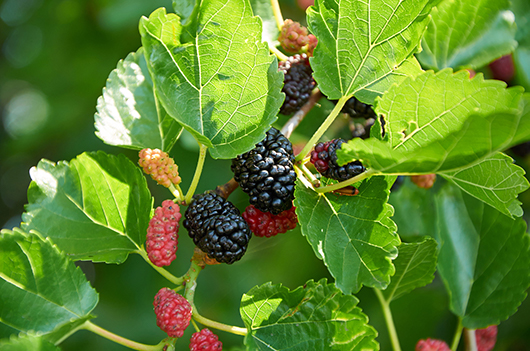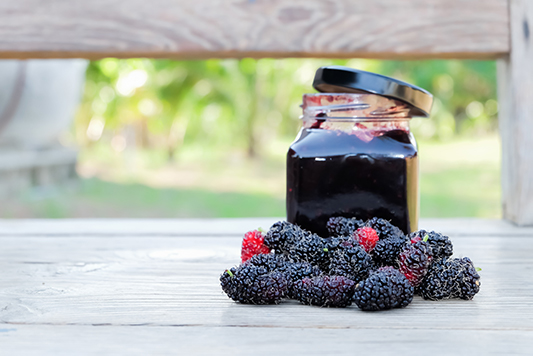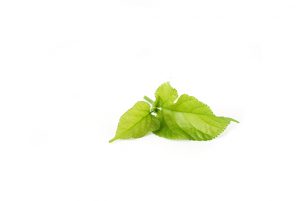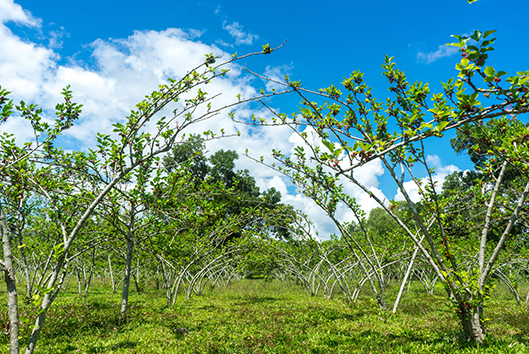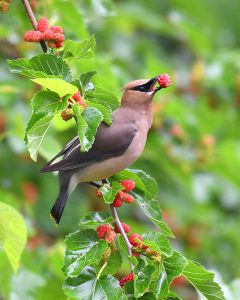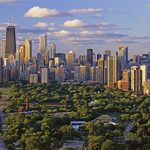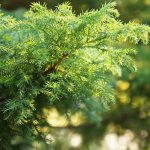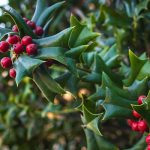Our series covering the native trees of the Chicago area returns with a look at the red mulberry tree (Morus rubra). The red mulberry tree is the only mulberry tree that is native to North America and it is found throughout the eastern half of the United States. These trees are also found in small numbers in British Columbia, but the red mulberry is considered an endangered species in Canada. There are 10 to 16 accepted species of mulberry trees native to southern Europe, north Africa, Asia, and the Middle East. Mulberry trees of all types are most easily recognized by their large fruits that closely resemble blackberries and raspberries.
Mulberry trees have been an important source of wood and food for different cultures throughout the world. The berries produced by the mulberry trees are edible when ripe and are used to make desserts, wine, tea, and supplements. The wood of red mulberries can be used to smoke meat and Cherokee tribes weaved fine fabric using the soft inner wood fibers. In this guide, we will discuss the main characteristics of red mulberry trees, their biggest natural threats, and how to care for them to keep them healthy and maximize their fruit yield. We will focus primarily on the red mulberry tree because this is the mulberry species native to the U.S. and the Chicago area, but we will also take a quick look at other common mulberry tree species found throughout the world.
Red mulberry trees are typically planted for ornamental purposes because of their showy fruit and fall colors. If your red mulberry trees receive the proper care, they can live for up to 50 years and produce significant fruit yields each season. At Hendricksen Tree Care, our ISA certified arborists can provide professional tree care and maintenance services to keep your red mulberry trees healthy and fruitful. We can help prevent, diagnose, and treat insect infestations and disease, properly fertilize your trees, and provide effective tree trimming services.
Characteristics of Red Mulberry Trees Native to Chicagoland
Red mulberry trees are deciduous trees that produce inconspicuous flowers and showy fruits. They tend to grow between 40 and 70 feet in height and have expansive, round canopies. Their fruits, which are red or dark purple in color when ripe, are their most defining characteristic.
The following are the main characteristics of the red mulberry:
- Height: While red mulberry trees can get as tall as 70 feet, they typically grow to be between 35 and 50 feet tall. Their canopy can get up to 40 feet wide and they have a small trunk with a diameter that can get up to two feet.
- Leaves: Red mulberry leaves vary in shape. They are generally tear drop shaped unlobed leaves, but some mulberry trees can have leaves with 3-5 lobes. All mulberry leaves have a finely serrated edge and the surface of the leaves may feel similar to sandpaper. They keep a dark green color in the growing season and turn yellow in the fall.
- Flowers: The flowers of a red mulberry tree are yellow or green in color and they grow in small, inconspicuous clusters. These trees are dioecious with male and female flowers on separate trees.
- Fruit: The fruit is the most recognizable characteristic of red mulberry trees as they bear large fruits that look similar to a blackberry. These fruits can be an inch to an inch and a half long and they are dark red or purple when they are ripe. These fruits are also edible and have a very sweet flavor.
- Bark: The bark of a red mulberry tree is smooth when the tree is young, and it becomes more deeply ridged with age.
Additional Species of Mulberry Trees
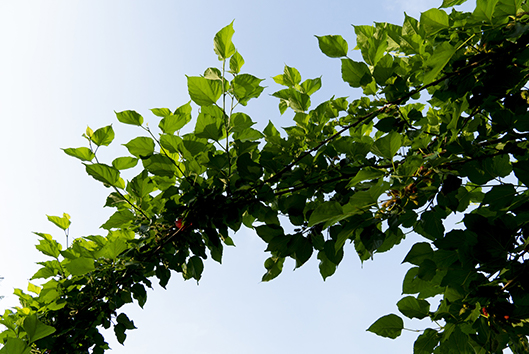
There are many species of the Mulberry tree, but only the Red Mulberry Tree is native to Chicagoland
There are many species of the Mulberry tree, but only the Red Mulberry Tree is native to Chicagoland
As mentioned above, there are 10 to 16 species of mulberry trees found around the world including Europe, Africa, and Asia. The following are the most common mulberry trees outside the U.S.:
- Black Mulberry: Black mulberry trees (Morus nigra) are medium sized trees found in the Middle East including Iran and the Levant. The bark, trunk, and branches of a black mulberry are very different from a red mulberry as they are often gnarled with large fissures and they usually lean at an angle. Its flowers look like small, spikey catkins and they have large edible fruits that are pink or dark purple when ripe.
- White Mulberry: White mulberry (Morus alba) trees are slender trees that are found in Asia including Korea, China, and Japan. These trees have lobed leaves and its fruits are small and may be white, pink, or dark red when ripe.
- Chinese Mulberry: The Chinese mulberry (Moras australis) is a medium size mulberry tree found in China and Japan. These trees have short trunks and wide canopies and their fruit ranges in color from white to dark purple.
- Long Mulberry: The long mulberry tree (Morus macroura) is found in Tibet and the Himalayas. This tree has a spreading canopy with long fruits that can be white, pink, or dark purple in color.
- African Mulberry: The African mulberry (Morus mesozygia) is a forest tree found in the tropical regions of African. They have a thick, round canopy and their fruits are a food source for chimpanzees and colobus monkeys.
- Peruvian Mulberry: The Peruvian mulberry (Morus insignis) is an evergreen mulberry tree found in parts of Central America and western regions of South America. The evergreen quality makes this tree unique from other mulberries.
Natural Threats to Red Mulberry Trees in Illinois
When healthy, red mulberry trees are beautiful ornamental trees with dark green leaves and showy red and purple fruit. However, there are several pests and diseases that can harm and even kill these trees. The following are the main natural threats to red mulberry trees:
Diseases
- Armillaria root rot: Armillaria root rot is a fungal disease that attacks the root system of the tree and spreads to affect the leaves and branches. Trees affected by this disease will have small leaves that are discolored and mushrooms may be found at the base of the tree. This disease can result in leaves dropping prematurely, dead branches, and eventually the death of the tree. This disease is difficult to control once it has taken hold.
- Cotton root rot: Cotton root rot is another fungal disease that is similar to Armillaria root rot. This disease attacks the roots of the tree and causes the leaves to turn yellow and wilt. The leaves and roots affected by this disease will stay attached to the tree after they die. Once this disease is visible, there is no saving the tree as the disease has already spread through the entire root system. Applying high nitrogen fertilizers can help prevent this disease.
- Bacterial blight: Bacterial blight is a disease caused by bacteria that attacks the leaves, fruits, and flowers of the red mulberry tree. Affected trees will have small black or large brown spots on the leaves, flowers, and fruits. This disease can be controlled by removing affected branches. However, if the tree has cankers on the trunk, then it will likely die and should be removed.
- Popcorn disease: Popcorn disease is a fungal disease that attacks the fruit of mulberry trees. This disease gets its name from the appearance of the affected fruits that become enlarged and misshapen. This disease does not affect the tree itself and can be controlled by picking and removing the affected fruits.
- Powdery mildew: Powdery mildew is a fungal disease that causes a white powdery substance to appear on the leaves. This disease can cause leaves to shrivel and stunt new growth. It is possible to treat trees affected by powdery mildew by spraying them with fungicide.
- Mulberry leaf spot: Mulberry leaf spot is a fungal disease that causes dark spots to form on the leaves. Mulberry trees that do not produce fruit are more susceptible to this disease than fruit bearing mulberry trees. Affected trees may be treated with fungicide spray, but many trees can survive this disease with no treatment.
Insects
- Whiteflies: The giant whitefly and mulberry whitefly are two types of whiteflies that affect mulberry trees. These flies are small insects with white bodies and wings and they generally appear on leaves that are low on the tree. They feed on juices from the leaves in every stage of their lifecycle and leave behind a secretion called honeydew that can cause sooty mold to form and attract other insects. These insects can cause yellowing and premature dropping of the leaves with heavy feeding. The best way to treat this problem is to spray the tree with water.
- Scales: Scales are small, largely immobile bugs that feed on the fluids from inside the tree. It is rare for a scale infestation to cause serious damage, but a large infestation can cause yellowing of the leaves and defoliation as well as cracks in the bark. Ensuring that the tree is properly fertilized and watered and removing heavily infested branches will help control a scale infestation.
- Mealybugs: Mealybugs are small white or pink colored bugs that are round in shape and appear to have little spines protruding from all around their bodies. They appear in large numbers on an affected tree and they produce honeydew where they feed on the plant. Healthy trees can tolerate a moderate infestation of mealybugs and their natural predators help keep them under control. If the infestation is too big, you can treat it by spraying water or insecticidal soap.
- Fall webworm: Fall webworms are caterpillars that are yellow or green in appearance with long white hairs, a stripe on its body, and a dark head. They form webs over the areas of the tree where they feed, and these webs can be several feet in diameter. These webs are largely a cosmetic issue and can be pruned out.
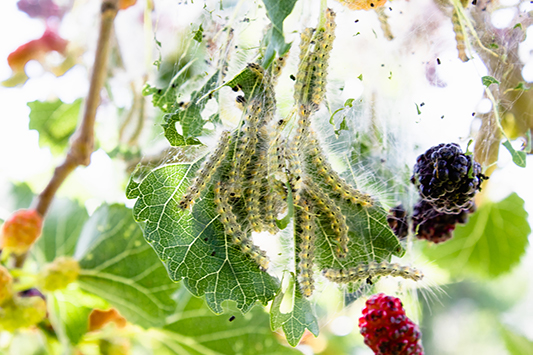
Caterpillars can be destructive to a Red Mulberry Tree, but can generally be pruned off if necessary
- Glassy-winged sharpshooter: The glassy winged sharpshooter is a brown, skinny bodied leafhopper that feeds on the sap from the tree. The effects of these insects are largely cosmetic as the eggs are covered with a white chalky material and the secretions of these insects can make the leaves appear whitewashed. The biggest danger with these insects is that they can spread bacteria that causes leaf scorch and other serious diseases. The glassy winged sharpshooter can be controlled biologically with natural predators and applications of insecticidal soap.
Red Mulberry Tree Care Tips
As we have already established, red mulberry trees can add much natural beauty to your yard or landscape, especially if they have a good fruit yield. With the proper care, your red mulberry tree can grow strong each growing season and produce the showy fruit it is known for. The following are care tips for red mulberry trees:
- Planting: Mulberry trees should be planted during the spring in an area where they will get full to partial sun. It is best if the soil is well-drained.
- Watering: Red mulberry trees are pretty drought resistant and prefer well-drained soil. However, you should still water them to keep the soil around the roots moist and water them during a drought.
- Mulching: A layer of mulch should be applied around red mulberry trees to help keep the soil moist. Make sure the mulch reaches out to the drip line and do not let the mulch touch the trunk of the tree.
- Fertilization: Fertilizing red mulberry trees once in the spring with 10-10-10 fertilizer will help keep them healthy and vibrant in the growing season.
- Pruning: Pruning the lateral branches of young mulberry trees in the middle of the summer can help facilitate new growth near the main limbs. However, you must make cuts of less than 2 inches because these trees have a tendency to bleed. After this initial pruning of young trees, they should only be pruned to remove dead or overcrowded branches. Pruning while the tree is dormant will help avoid bleeding issues. If you are not comfortable pruning your red mulberry trees yourself, you can have a professional arborist take care of the tree pruning.
Professional Tree Care for Red Mulberry Trees from Hendricksen Tree Care
Red mulberry trees are a favorite ornamental tree because of their dark green leaves and showy red or purple fruits, and their fruits are also sweet and edible for those interested in harvesting them. However, if these trees are not cared for properly, they will not have good fruit yields and may become susceptible to fungal diseases and pests. Our professional arborists at Hendricksen Tree Care can help those in the Chicago area take proper care of their red mulberry trees and ensure that they are healthy enough to resist disease and insect infestations and grow to their full potential.
Hendricksen Tree Care is a Tree Care Industry Association (TCIA) accredited arborist that provides a range of tree care services including tree pruning, fertilization, and tree treatment and diagnosis for pests and diseases. Our arborists will assess the condition of your trees and ensure that they get the care they need to grow strong during the growing season. Hendricksen Tree Care provides services for residential and commercial properties in Arlington Heights, Winnetka, Palatine, Northbrook, Barrington, Lake Zurich, Park Ridge, and the surrounding north and northwest Chicago suburbs.
